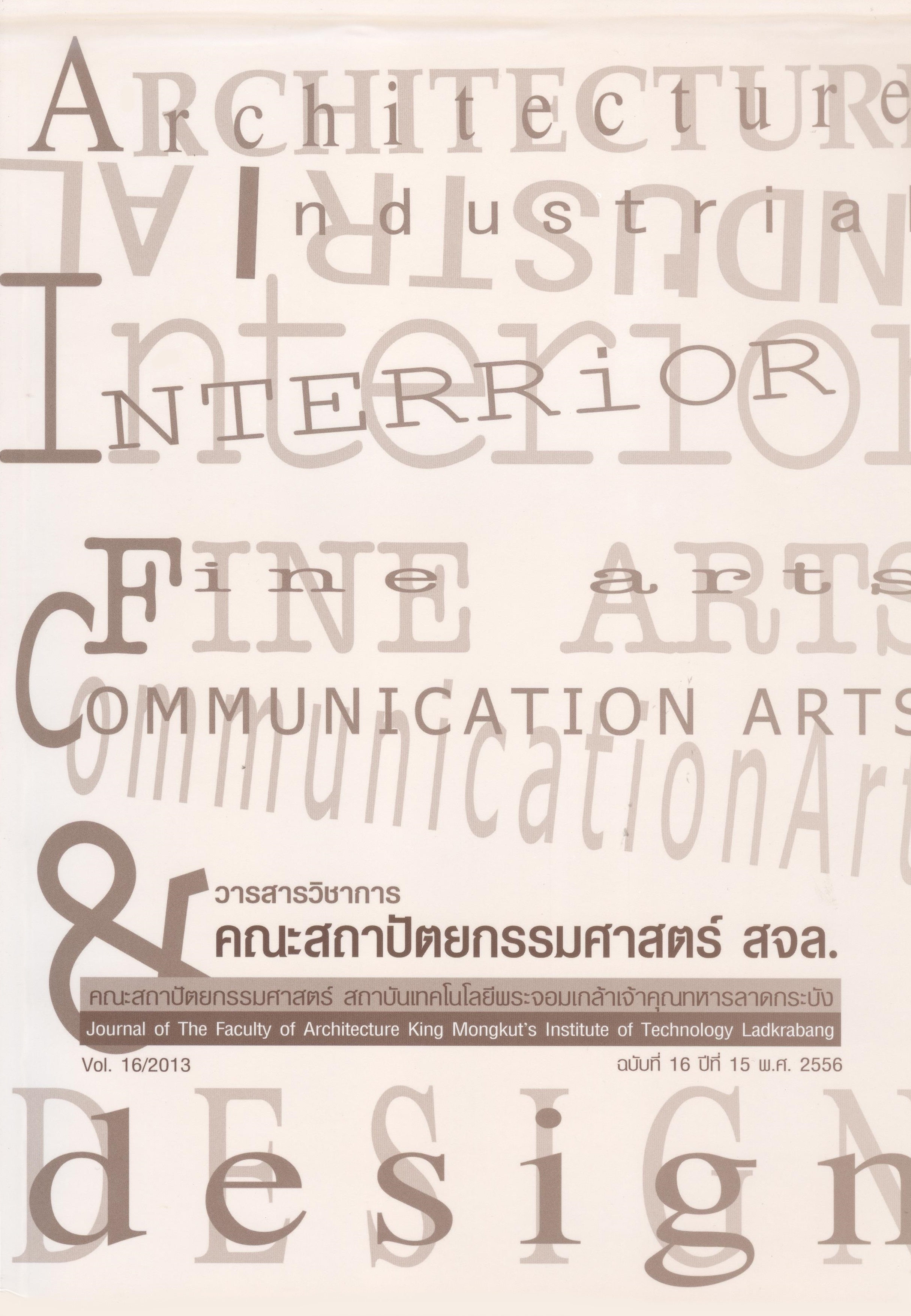ตำนาน พิธีกรรมและสถาปัตยกรรม (Ayth, Ritual and Architecture)
Main Article Content
Abstract
บทคัดย่อ
ในการศึกษาทางประวัติศาสตร์และมานุษยวิทยา ตำนาน เรื่องเล่าต่างๆ ถือเป็นหลักฐานที่สำคัญประการหนึ่งที่ใช้สืบค้นประวัติความเป็นมาและบอกเล่าเหตุการณ์ต่างๆ ที่เกิดขึ้นในอดีต โดยปกติแล้วตำนานและเรื่องเล่าที่แสดงถึงความเชื่อของคนในสังคมต่างๆ นั้น จะมีความสัมพันธ์อย่างแนบแน่นและแสดงออกผ่านพิธีกรรมในหลากหลายรูปแบบ โดยเฉพาะการศึกษาด้านสถาปัตยกรรม การมีความรู้ความเข้าใจในความสัมพันธ์ระหว่างพิธีกรรม ความเชื่อ กับตำนานต่างๆ นั้น เปรียบเสมือนหลักฐานอันสำคัญที่ช่วยส่งผ่านข้อมูลและเรื่องราวต่างๆ ในอดีต โดยเฉพาะข้อมูลทางประวัติศาสตร์และวัฒนธรรมที่เกี่ยวเนื่องกับสถาปัตยกรรมและสภาพแวดล้อม แต่ความสัมพันธ์ระหว่างตำนาน พิธีกรรมและสถาปัตยกรรมและสภาพแวดล้อมและสภาพแวดล้อม แต่ความสัมพันธ์ระหว่างตำนาน พิธีกรรมและสถาปัตยกรรมนั้น มักถูกละเลยและถูกปฏิเสธที่จะให้ความสำคัญในการศึกษาจากนักวิชาการทางสถาปัตยกรรม เนื่องจากถูกมองว่าเป็นสิ่งที่ไร้สาระ ล้าสมัย และไม่สามารถอธิบายด้วยเหตุและผลได้ ทั้งๆ ที่เราไม่สามารถปฏิเสธได้เลยว่า ตำนานและพิธีกรรมนั้นถือเป็นสิ่งที่ช่วยอธิบายความสัมพันธ์และพัฒนาการระหว่างมนุษย์และสถาปัตยกรรมได้เป็นอย่างดี จากเหตุผลดังกล่าว “แนวคิดมานุษยวิทยาสถาปัตยกรรม” จึงกำเนิดขึ้นโดยมีจุดประสงค์ หลักเพื่อพยายามอธิบายความสัมพันธ์ระหว่างมนุษย์และสถาปัตยกรรมด้วยมุมมองทางมนุษยวิทยาจากข้อมูลทางเอกสารและวรรณกรรมต่างๆ บทความนี้มุ่งเน้นนำเสนอแนวคิดและพัฒนาการของ “แนวคิดมานุษยวิทยาสถาปัตยกรรม” โดยเฉพาะความสัมพันธ์ระหว่างตำนาน พิธีกรรมและสถาปัตยกรรมที่บอกเล่าผ่านโลกทัศน์และกระบวนการสร้างสภาพแวดล้อมของคนในสังคมและวัฒนธรรมต่างๆ
คำสำคัญ: ตำนาน พิธีกรรม สถาปัตยกรรม มานุษยวิทยาสถาปัตยกรรม
Abstract
In historical and anthropological studies, traditional narratives such as a myth and storytelling are considered as key evidence to trace the origins of society. Myth always determines ritual practice that it accompanies, it implies ritual, ritual implies myth, and they might be the same. However, myth and ritual are often ignored by modernized people, since they are considered to be irrational and intimately related to unexplainable an d su0pernatural circumstances. Especially in the study of architecture, myth and ritual always stand for a nonsensical belief and suspicious story. Even though they can reveal enriching information and carry cultural messages which were underlying in architecture and its related built environment. They seem to be refused by many scholars, who rely on a rational and practical perspective. If we trace back to the past, myth and ritual can help us to understand how our ancestors create their built environment. They may serve the study of architectural history and the analysis of relationships between men, architecture, and their surrounding world. For this reason, many scholars have begun to connect architectural works with the development of social and cultural anthropology. The idea of “architectural anthropology” has been suggested to describe the interrelation between architecture, men and their related built environment. Based extensively on foregoing descriptions, this paper devotes the attention to exemplify the idea and chronological development of “architectural anthropology”. In addition, the interrelation between myth, ritual and architecture will be explicated in this paper.
Keywords: Myth Ritual Architecture Architectural Anthropology
Article Details
This work is licensed under a Creative Commons Attribution-NonCommercial-ShareAlike 4.0 International License.
Copyright Transfer Statement
The copyright of this article is transferred to Journal of The Faculty of Architecture King Mongkut's Institute of Technology Ladkrabang with effect if and when the article is accepted for publication. The copyright transfer covers the exclusive right to reproduce and distribute the article, including reprints, translations, photographic reproductions, electronic form (offline, online) or any other reproductions of similar nature.
The author warrants that this contribution is original and that he/she has full power to make this grant. The author signs for and accepts responsibility for releasing this material on behalf of any and all co-authors.


